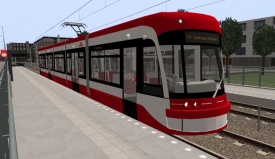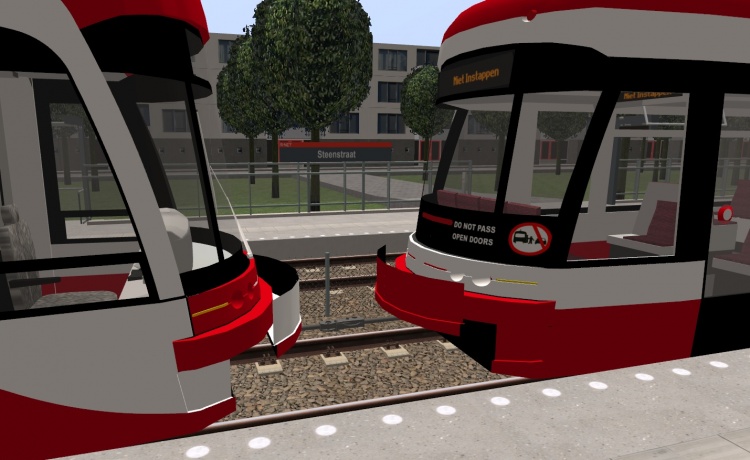Flexity Outlook: Difference between revisions
(Created page with " {{Rolling stock |naam = Toronto Flexity Outlook |afbeelding = |beschrijving = <div style="text-align:center;"> 275px </div> |beschrijving2 = |serie...") |
No edit summary |
||
| (14 intermediate revisions by 4 users not shown) | |||
| Line 1: | Line 1: | ||
{{Rolling stock | {{Rolling stock | ||
| | |name = Toronto Flexity Outlook | ||
| | |image = Toronto_TTC_1.jpg | ||
|size = 275px | |||
| | |series = 4401-4475 | ||
|series = | |traction = overhead wire | ||
| | |protection = [[ATB]]/[[ROZ]] max. 70km/h | ||
|protection = | |download = {{TorontoLink}} | ||
| | |||
}} | }} | ||
'''Note 23-12-2021:''' Updated to be compatible with Hageningen tram network in Metrosimulator 3.17, by adding "ROZ" (Rijden op Zicht / Drive on sight, as alternative to ATB and ZUB train protection). | |||
If you want to use these trams on this tram network and you have downloaded this package before this date, please re-download. | |||
The Flexity Outlook is the latest model in the rolling stock of the Toronto tram system owned by the Toronto Transit Commission (TTC). Based on the Flexity Outlook vehicles used in several European cities, the new trams were first ordered in 2009 and | The Flexity Outlook is the latest model in the rolling stock of the Toronto tram system owned by the Toronto Transit Commission (TTC). Based on the Flexity Outlook vehicles used in several European cities, the new trams were first ordered in 2009 and were built by Bombardier Transportation in Thunder Bay, Ontario, Canada. | ||
The Flexity Outlook is the first modern low-floor and wheelchair accessible tram used in the city. With a length of over 30 metres (98 ft), they are also the largest trams in the system. They have four sliding doors, air conditioning systems, seating for up to 70 passengers, and interior bicycle racks. | The Flexity Outlook is the first modern low-floor and wheelchair accessible tram used in the city. With a length of over 30 metres (98 ft), they are also the largest trams in the system. They have four sliding doors, air conditioning systems, seating for up to 70 passengers, and interior bicycle racks. | ||
The vehicle is based on Bombardier's standardized Flexity Outlook product, which is also used in cities like Brussels, Marseille, and Geneva, but tailored to Toronto's needs. For example, as the older trams on the Toronto network still use trolley poles, the new trams had to be fitted with trolley poles too, while the overhead wire system is being modified for pantograph use. | The vehicle is based on Bombardier's standardized Flexity Outlook product, which is also used in cities like Brussels, Marseille, and Geneva, but tailored to Toronto's needs. For example, as the older trams on the Toronto network still use trolley poles, the new trams had to be fitted with trolley poles too, while the overhead wire system is being modified for pantograph use. | ||
==Operations In Simulator== | ==Operations In Simulator== | ||
| Line 31: | Line 29: | ||
- Station Buitenvelden - Statenpolder <br> | - Station Buitenvelden - Statenpolder <br> | ||
<br> | <br> | ||
On the Metrosimulator model, the trolley pole has not been included; the simulator does not facilitate its use, and it can be expected that | Rijndam 2022 Full version (1.2/1.3.1): <br> | ||
- Centraal Station - Garenmarkt <br> | |||
- Centraal Station - Station Buitenvelden <br> | |||
- Centraal Station - Statenpolder <br> | |||
- Station Buitenvelden - Statenpolder <br> | |||
<br> | |||
[[Toronto_Streetcar]]: <br> | |||
- Entire network <br> | |||
<br> | |||
On the Metrosimulator model, the trolley pole has not been included; the simulator does not facilitate its use, and it can be expected that on the real trams, the trolley poles will be removed when the entire Toronto network has been modified for pantograph use. <br> | |||
<br> | <br> | ||
The model is equiped with four passenger views; <br> | The model is equiped with four passenger views; <br> | ||
4 - | 4 - Section 1, left side, facing rear <br> | ||
5 - | 5 - Section 3, right side, facing front <br> | ||
6 - | 6 - Section 5, left side, facing front <br> | ||
7 - | 7 - Section 5, back seats, facing front <br> | ||
<br> | <br> | ||
The trams can be coupled together. In reality, this is for emergency use only (to pull or push a defective unit). In Metrosimulator, the trams can be used coupled in passenger service (if the platforms you are passing are long enough). The couplings will automatically appear when you join two units together.<br> | The trams can be coupled together. In reality, this is for emergency use only (to pull or push a defective unit). In Metrosimulator, the trams can be used coupled in passenger service (if the platforms you are passing are long enough). The couplings will automatically appear when you join two units together.<br> | ||
| Line 44: | Line 52: | ||
[[File:Toronto_TTC_2.jpg|750px]] | [[File:Toronto_TTC_2.jpg|750px]] | ||
==Special animations== | |||
Shift+X - Open/close driver door<br> | |||
Ctrl+Shift+X - Activate/deactivate window wipers | |||
<br style="clear:both"/> | <br style="clear:both"/> | ||
{{Navigatie RollingStock}} | {{Navigatie RollingStock}} | ||
Latest revision as of 12:34, 31 December 2021
| Toronto Flexity Outlook | ||||||
|---|---|---|---|---|---|---|
 | ||||||
| Series | ||||||
| 4401-4475 | ||||||
| Traction power supply | ||||||
| overhead wire | ||||||
| Protection | ||||||
| ATB/ROZ max. 70km/h | ||||||
| Download |
Note 23-12-2021: Updated to be compatible with Hageningen tram network in Metrosimulator 3.17, by adding "ROZ" (Rijden op Zicht / Drive on sight, as alternative to ATB and ZUB train protection). If you want to use these trams on this tram network and you have downloaded this package before this date, please re-download.
The Flexity Outlook is the latest model in the rolling stock of the Toronto tram system owned by the Toronto Transit Commission (TTC). Based on the Flexity Outlook vehicles used in several European cities, the new trams were first ordered in 2009 and were built by Bombardier Transportation in Thunder Bay, Ontario, Canada.
The Flexity Outlook is the first modern low-floor and wheelchair accessible tram used in the city. With a length of over 30 metres (98 ft), they are also the largest trams in the system. They have four sliding doors, air conditioning systems, seating for up to 70 passengers, and interior bicycle racks.
The vehicle is based on Bombardier's standardized Flexity Outlook product, which is also used in cities like Brussels, Marseille, and Geneva, but tailored to Toronto's needs. For example, as the older trams on the Toronto network still use trolley poles, the new trams had to be fitted with trolley poles too, while the overhead wire system is being modified for pantograph use.
Operations In Simulator
As this is a unidirectional vehicle, you can only use this tram on routes with turning loops on both ends.
Rijndam 2020 and Rijndam 2022 Light version:
- Station Buitenvelden - Statenpolder
Rijndam 2022 Full version (1.1):
- Centraal Station - Station Buitenvelden
- Centraal Station - Statenpolder
- Station Buitenvelden - Statenpolder
Rijndam 2022 Full version (1.2/1.3.1):
- Centraal Station - Garenmarkt
- Centraal Station - Station Buitenvelden
- Centraal Station - Statenpolder
- Station Buitenvelden - Statenpolder
Toronto_Streetcar:
- Entire network
On the Metrosimulator model, the trolley pole has not been included; the simulator does not facilitate its use, and it can be expected that on the real trams, the trolley poles will be removed when the entire Toronto network has been modified for pantograph use.
The model is equiped with four passenger views;
4 - Section 1, left side, facing rear
5 - Section 3, right side, facing front
6 - Section 5, left side, facing front
7 - Section 5, back seats, facing front
The trams can be coupled together. In reality, this is for emergency use only (to pull or push a defective unit). In Metrosimulator, the trams can be used coupled in passenger service (if the platforms you are passing are long enough). The couplings will automatically appear when you join two units together.
Special animations
Shift+X - Open/close driver door
Ctrl+Shift+X - Activate/deactivate window wipers
